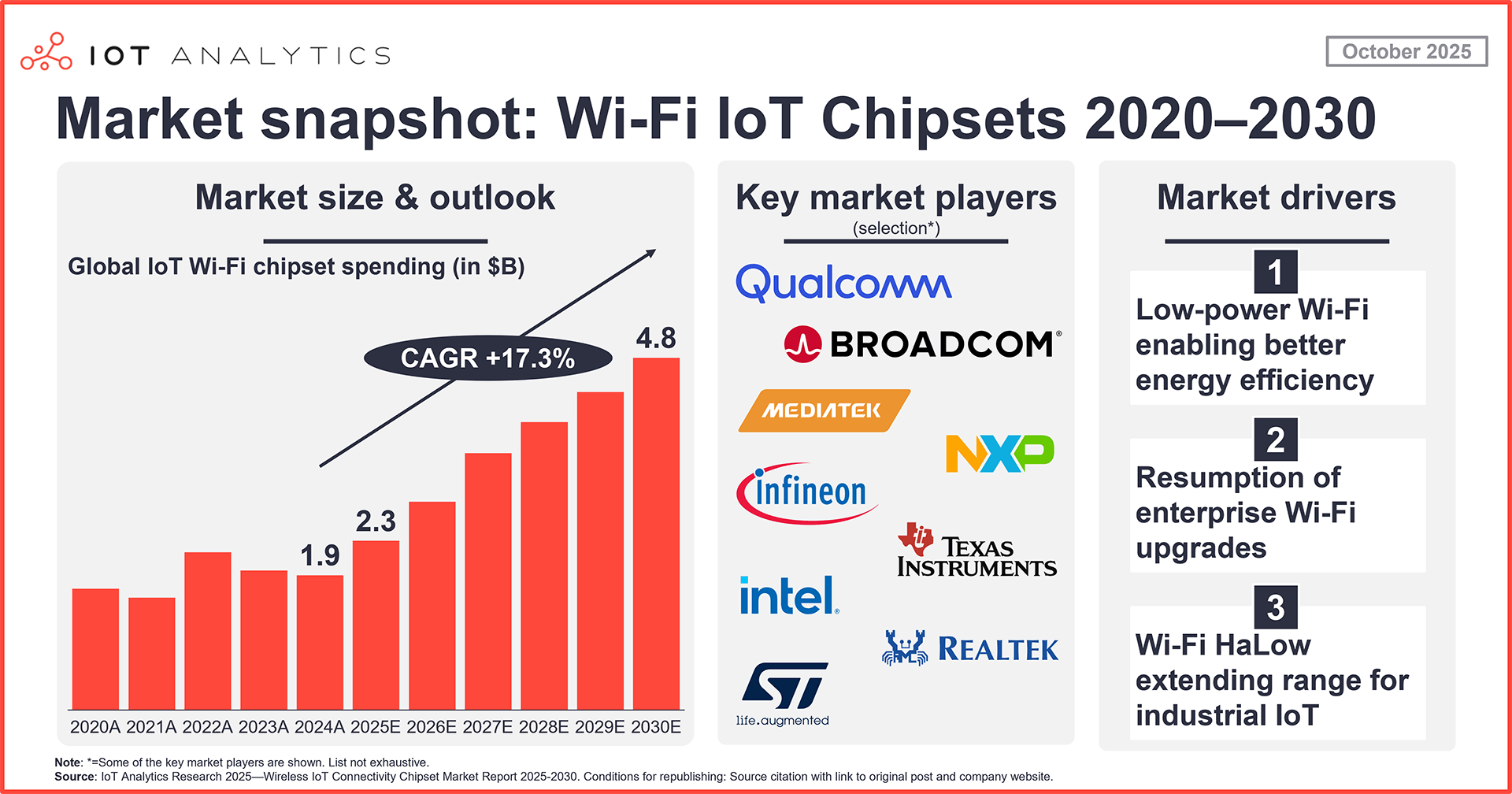

IoT Analytics has published its latest research on the Wi-Fi IoT chipset market, forecasting a strong rebound and a 17.3% compound annual growth rate (CAGR) to reach $4.84 billion by 2030. The analysis, part of the Wireless IoT Connectivity Chipset Market Report 2025–2030, identifies three key drivers for this growth: the adoption of low-power Wi-Fi chipsets, the resumption of enterprise Wi-Fi upgrades to new standards like Wi-Fi 6E and 7, and the emergence of Wi-Fi HaLow for long-range applications.
The market, which reached $1.85 billion in 2024, is recovering from a contraction caused by inventory corrections and a higher mix of low-end chipsets. The report forecasts an acceleration in spending as new Wi-Fi standards enable better energy efficiency, reliability, and extended range, making Wi-Fi a more viable option for a wider range of battery-powered IoT devices.
The research highlights a competitive market, with Qualcomm (19%) and Broadcom (18%) holding the largest market shares in 2024.
Satyajit Sinha, Principal Analyst at IoT Analytics, comments that:
“Wi-Fi is expanding into new segments of IoT, with low-power Wi-Fi and Wi-Fi HaLow addressing the power and range limitations that previously favoured other protocols. Low-power Wi-Fi enables battery-operated devices, such as smart locks, sensors, and cameras, to function efficiently within Wi-Fi environments. This challenges the dominance of LPWAN and proprietary short-range protocols in low-power use cases. Wi-Fi Hallow offers long-range, sub-GHz connectivity with support for IP and video. It is well-suited for industrial and agricultural applications including remote monitoring, perimeter surveillance, and large-site control systems. Together, these technologies reposition Wi-Fi as a flexible IoT chipset that can support both constrained and high-bandwidth applications.”
Wi-Fi IoT chipset market snapshot and outlook

Wi-Fi IoT chipset market to surpass $4 billion in 2030 after low-end chipsets dragged market. After 2 years of market contraction, the Wi-Fi IoT chipset market is forecast to rebound from $1.85 billion in 2024 to $2.32 billion in 2025, according to IoT Analytics’ 156-page Wireless IoT Connectivity Chipset Market Report 2025–2030 (published October 2025). According to the report, this rebound is just the start of an expected market acceleration. Between 2024 and 2030, the market is forecast to grow at a CAGR of 17.3%, reaching $4.84 billion by the end of the decade. The contraction in 2023–2024 was mainly due to inventory corrections and a higher mix of low-end 2.4Ghz chipsets.
Several drivers are set to propel enterprise Wi-Fi IoT chipset spending, as discussed below.
Wi-Fi IoT chipset market drivers
1. Low-power Wi-Fi enabling better energy efficiency
Wi-Fi 6 expanding support for low-power devices. Wi-Fi 6 has brought power-saving features to the technology, such as Target Wake Time (TWT) and extended sleep modes. TWT enables client devices and access points (APs) to schedule specific times for communication, allowing devices to spend more time in standby mode and transfer data only when necessary. Meanwhile, extended sleep modes, like those found in “Wi-Fi for Matter,” reduce client duty cycles. These technologies are making Wi-Fi a viable option for battery cameras, smart locks, sensors, and small appliances.
Examples
- Silicon Labs’ SiWx917 integrates ultra-low-power Wi-Fi 6 with TWT
- Qualcomm QCA4010/QCA4020 families enable low-power embedded Wi-Fi
2. Resumption of enterprise Wi-Fi upgrades
Enterprise IoT upgrades rebounded in 2025. Enterprise IoT spending slowed in 2023 and 2024, particularly for IoT hardware, such as gateways and controllers. The tide appears to be shifting, though, as IoT Analytics’ market models show an upswing in early 2025. Upgrades that had been postponed are now set to resume, and with that, organizations will begin replacing older Wi-Fi networks with newer technologies to enhance reliability and speed:
- Wi-Fi 6E: Approved by the US Federal Communications Commission in 2020, Wi-Fi 6E added 6 GHz on top of the traditional 2.4 GHz and 5 GHz frequency bands, meaning newer devices can access faster speeds without interference from legacy devices.
- Wi-Fi 7: Released in January 2024, Wi-Fi 7 introduced Multi-Link Operation (MLO), which allows devices to use multiple frequency bands simultaneously for increased speed and reliability.
3. Wi-Fi HaLow
Wi-Fi HaLow extending range for industrial IoT. Wi-Fi HaLow (IEEE 802.11ah) was originally published in 2017, but first real-world commercial deployments only started in 2024 with mass production of Wi-Fi HaLow chips beginning in 2025. Wi-Fi HaLow operates below 1 GHz, which gives it greater obstacle penetration and range. Indoor tests showed coverage of hundreds of meters per AP, and field trials have shown outdoor video connections as far as 16 km at 2 Mbps. However, this distance is under optimal conditions with a clear line of sight, and most vendors cite a few kilometers for reliability. Wi-Fi HaLow opens new opportunities for Wi-Fi IoT connectivity, such as large indoor factory connectivity and long-range remote monitoring of crops and livestock.
“The Wi-Fi HaLow evolution marks a significant advancement in IoT technology, promising to enhance connectivity across a broad spectrum of applications. In the next four to five years, it is expected that Wi-Fi halo will sell close to 100 million devices in the field, and it’s accelerating in the USA and slowly starting in Europe as well.” – Mike Danil, CEO at Morse Micro
The post Wi-Fi IoT Chipset Market to Hit $4.8 B by 2030 as New Standards Boost Performance appeared first on IoT Business News.
